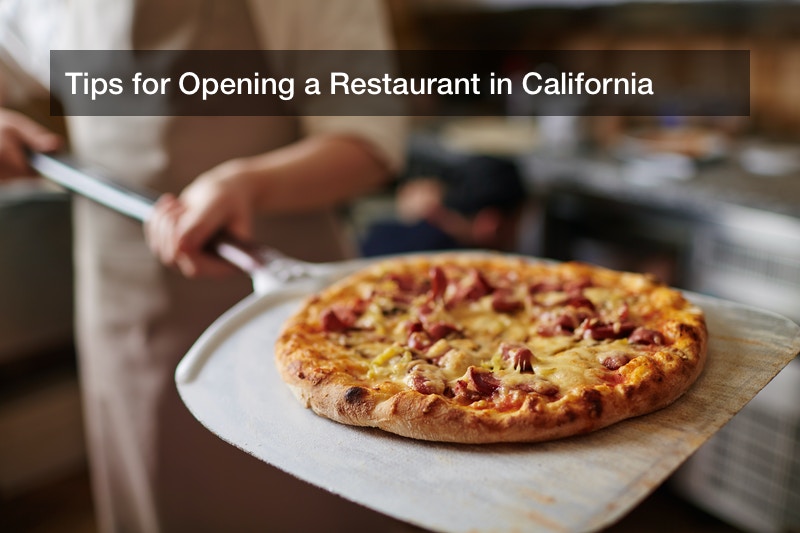
The restaurant business can be difficult. Renting space is expensive, margins are thin, and labor can be hard to find. However, opening a restaurant in California fulfills a lifelong dream for many restaurant owners. The satisfaction of bringing joy to guests through your own culinary creations cannot be matched. Moreover, hard work and good planning can make a restaurant a successful business that you can pass down through your family for generations to come.
Since many aspiring restaurateurs are artists rather than business experts at heart, knowing the steps for opening a restaurant in California might require research and consultations with experts like accountants, lawyers, and business coaches. Here is a summary of ten tips for opening a restaurant in California:
Tip #1: Start Early
Opening a restaurant in California requires a lot of time. Commercial construction, building inspections, health permits, vendor agreements, and hiring talent, to name just a few tasks, can require a year or more to complete.
On the positive side, this time is not idle. While you are waiting for construction, permits, and inspections, you can work on some of the other tasks such as designing your menu and researching kitchen equipment.
The more lead time you build into your plan, the better the chances are that you will meet your planned opening date. This is critically important to your marketing efforts. If you promote your opening date as March 5, you need to do everything possible to make that date or your marketing dollars spent promoting that date will be wasted.

Moreover, landlords, insurance companies, health inspectors, and vendors expect you to make your opening date and commence business operations. If you do not, you risk breaching contracts or having to negotiate costly extensions.
Worse yet, the longer you spend preparing to open your restaurant, the longer you will have huge expenses with no revenue. This could drive your restaurant out of business before it even opens.
Tip #2: Create Your Concept
Your restaurant’s concept is key to every other step of opening a restaurant in California. Without knowing the concept you cannot create a name, decor, architecture, menu, or marketing collateral. You cannot get a domain name or design a website. You cannot even apply for a health permit.
A restaurant concept can be thought of as the brand of the restaurant. Your restaurant’s brand will tell potential customers what to expect if they patronize your restaurant. Some questions to consider when developing your brand include:
- Is it fun and casual or serious and formal?
- Is it family-friendly?
- What kind of service does the restaurant offer?
- What price range do customers pay?
- What is the restaurant’s theme?
- What is the restaurant’s menu?
- How will customers recognize the restaurant?
This last question is key. Your restaurant’s brand will differentiate it from other restaurants. For example, if you choose to open a Mexican restaurant and use the same Mexican food distributors as your competitors, you will need to give customers something to identify your restaurant among a sea of restaurants.
Tip #3: Location
Whether you intend to rent or build space, you should place as much focus on the location as on the design or size of your building.

Location is critically important for a few reasons:
- Population: You need a critical mass of the population to draw enough customers. You should consider the population in relation to your brand. For example, being in an urban center might provide huge traffic from office workers during the day but might provide only sparse traffic at night and weekends.
- Parking: Opening a restaurant in California always requires consideration of parking. For example, if you are located in downtown LA, you will need to rely on existing pay lots and parking structures for your customers to park. If you are in the suburbs, you can hire an asphalt paving contractor to create a parking lot for you.
- Visibility: Customers need to be able to see your signage and find your location. While locating in a mall food court might bring you traffic when the mall is busy, you might not receive much traffic from outside the mall. Conversely, locating on a major street might bring you both pedestrian and auto traffic.
- Accessibility: Similar to visibility, accessibility is necessary to have a successful restaurant. If your restaurant is located in a remote area or a dangerous neighborhood, you might not get as many customers as a restaurant located in a safe neighborhood with good access.
Tip #4: Hire Builders and Designers Familiar with Restaurants
Designing and building a restaurant is very different from designing and building other types of buildings. Due to health codes, fire regulations, work flows, and customer accessibility, restaurants have different needs than office buildings or retail stores. Consequently, you should consider hiring designers and builders experienced in the restaurant industry to avoid inefficiencies and problems with health and fire inspectors.
For example, restaurants have enormous needs for heating and air conditioning, electricity, gas, and water in their kitchens. Your kitchen staff will complain if your kitchen is not capable of meeting their needs and customers will complain if the kitchen is inefficient. However, interviewing your builders to make sure your commercial plumbing, electrician, HVAC, and gas contractors have had experience on restaurant projects can ensure your kitchen will comply with codes and have adequate capacity.
Tip #5: Consult an Accountant or Financial Expert Before Seeking Funding
Developing a budget before opening a restaurant in California might be the most difficult budgeting you will ever do. However, a budget will be necessary for investors and lenders that you solicit for funding. As a result, your numbers will need to be realistic and supported by verifiable financial models.
If you are an expert in finance, you might be capable of creating budgetary projections and identifying the risks that might cause your projections to be wrong. If you are not a financial expert, you should consult an accountant or financial expert for a few reasons:
- Budget shortfalls: If you do not raise sufficient funds your project might never get off the ground. An expert can make sure that you have included everything that you will need for your restaurant to open. From linens to a garbage hauling service, experts in restaurant accounting and finance can identify all those expenses that you might forget about.
- Loss of confidence: If your budgets are consistently off, your lenders and investors could lose confidence in your ability to run your business. Once you lose their confidence, they could pull out and leave you without the funds to operate your restaurant. Professional accountants and financial advisors can help you update your budget as circumstances change to minimize the variance with your actual spending.
- Fraud: If your lenders or investors believe that you are deliberately misleading them as to your restaurant’s spending, they could sue you for fraud or, worse yet, report you to the California Attorney General’s office for defrauding them. Hiring accountants experienced in restaurant finance can protect you and your restaurant from accusations of fraud.
Tip #6: Inspect Your Space Multiple Times Before Signing Off

Each time you walk through your space to approve the construction, bring an independent building inspector with you. This expert will help you identify any construction issues before you accept the builder’s work and release your final payment.
Importantly, this could help you avoid issues with building inspectors, health inspectors, and fire inspectors. Unlike a private warehouse that might spend considerable time unoccupied, your restaurant is a public building. As a public building, inspectors will scrutinize the design and construction of your build out (if renting) or building. If any problems are found in the fire suppression systems, structure, electrical system, or a myriad of other systems, you will be denied a certificate of occupancy until those problems are resolved.
These problems could be costly and time-consuming to fix, particularly if the opening date is looming. Even if the builder agrees to foot the bill for the repairs, your opening could be delayed, costing you valuable business.
Tip #7: Line Up Your Supply Chain
One of the keys to running a restaurant is to line up the sources for all of the supplies you need. Remember, opening a restaurant in California requires more than just ingredients for your menu. It also requires cleaning supplies, kitchen tools, linens and paper products, utensils, take-out containers or plates, and many more supplies.
Fortunately, freight logistics services can often coordinate the delivery of supplies from the manufacturers or distributors to your restaurant. However, you will need an internal system for placing orders and tracking inventory. Moreover, you will need an inventory control system to make sure that supplies are being used efficiently, without waste or theft.
The best way to arrange your supply chain is to work with a good distributor that has access to quality products at a price you can afford. Unfortunately, you might need to shop around to find such a distributor. If you do, it can make a world of difference to the profitability of your restaurant to receive complete shipments on time and within budget.
Tip #8: Pass Your Health Inspections
One of the quickest ways to earn a bad reputation is to fail a health inspection. To reduce the risk of failing, you can hire a consultant to review your procedures and practices. These food safety consultants specialize in quality control. This means that they can help you to implement safe procedures and rules that will keep you on the right side of the health code.
For example, food safety consultants can help you develop processes for pest control to prevent infestations from occurring. This will avoid the need to shut down for cleaning and fumigation after opening a restaurant in California. These shutdowns can cost you business as customers will avoid your restaurant out of fear of disease or contamination.
Tip #9: Train Your Management and Staff

With your policies and procedures designed by food safety consultants, begin training your management well before opening a restaurant in California. When management is well-versed in your rules and procedures, they can pass their knowledge on to the staff they hire.
In fact, make your rules and procedures part of your business culture. A business that takes safety and quality seriously is more likely to maintain its standards for safety and quality. As soon as management and staff begin to allow safety and quality to slip, you need to act quickly to avoid an irreversible drop-off.
To avoid slippage, have periodic training sessions to refresh everyone’s commitment to following your rules and policies. Provide incentives for management and staff to report problems rather than turning a blind eye or, worse yet, sweeping problems under the rug.
For example, develop a quality control team that has the authority to hear concerns from staff and take action without involving a bureaucracy. For example, if a staff member sees mice droppings, rather than hiding the problem by admonishing the staff member to keep quiet, the quality control team should be empowered to call an exterminator or animal control to take care of the problem immediately.
Equally importantly, if the problem implicates any health rule, the quality control team should have the authority to self-report the problem to the health district. This way, inspectors do not feel blindsided if they discover a problem that should have been reported.
Tip #10: Put Up the Biggest Sign You Are Allowed
As mentioned above, visibility is one of the keys to success after opening a restaurant in California. Americans eat out around four times per week, but Americans are often reluctant to try new restaurants.
The reasons for this vary from customer to customer. Many restaurant customers are very brand-loyal and will return to the same place even if the quality of the food and service is not stellar. Essentially, the mindset is that they generally prefer to stick with what they know if it means avoiding a truly awful experience.
A big sign can help attract customers. Even if the sign is expensive to build and install by roofing contractors, signs last a long time and can have considerable benefit t your business. Some benefits include:
- Your restaurant will be easier to find. Since word-of-mouth is critically important to your marketing, you want new customers to be able to find you easily if all they know is your general location and the type of food you serve.
- A big sign implies success and, as the saying goes, success breeds success. If passersby believe that you are already successful, they are more likely to try your restaurant.
- It builds your brand. There is some research that suggests a customer must have five to seven impressions before the customer recognizes your brand. A big sign on a busy street is much more likely to create brand recognition.

Opening a restaurant in California is not an easy task. California has many regulations that you must understand and comply with to build a successful restaurant business. While you might be reluctant to spend money on accountants, engineers, and other consultants, you might actually save money in the long run by avoiding fines and shut-downs. In the end, California has one great advantage — the large population can help a newcomer to the restaurant business succeed. By laying the groundwork for your restaurant before you open, it can do just that.


